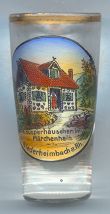

|
| DEUTSCHLAND | GERMANY |
| Bundesland: Rheinland-Pfalz | Rhineland-Palatinate |
| Landkreis: Mainz-Bingen |
Niederheimbach is situated at an elevation of 120 m on the left bank of the Rhine at the entrance of the Heimbach valley in the UNESCO World Natural Heritage area Upper Middle Rhine valley.
Archeological finds show that the area was inhabited for several thousands of years. The oldest finds date from the Neolithic period (1000–1800 BC). Celtic tribes have lived here from about AD 450, the Romans have left their traces from the 1st until the 4th century. The Heimbach stream was first mentioned in a document of AD 955, the village itself as Heigenbach in 1059. The distinction between Niederheienbach (Niederheimbach) and Heienbach superior (Oberheimbach) was made as early as 1235. Until the Thirty Years' War (1618–1648) Niederheimbach was a flourishing community. Destruction by fire and looting (1639) and the Plague (1625 and 1666) caused a long period of poverty. In the 18th century viniculture and the river navigation on the Rhine were the main sources of income for Niederheimbach. The stretch of the river between Niederheimbach and Bingen am Rhein upstream was treacherous and every ship was required to take a pilot on board at Niederheimbach. In 1794 the German territories to the left of the Rhine were occupied by France, and in 1798 the area of Niederheimbach became part of the canton Bacharach within the préfecture Coblentz (Koblenz). After the Congress of Vienna (1815) it became part of the Prussian Lower Rhine province. In 1830–1832 and in 1892–1901 the fairway in the river was widened and deepened. Nevertheless, this stretch of the Rhine remained the most dreaded one in the course of the river up until 1974.

The  Märchenhain ('grove of fairy-tales') was created in 1926 and was a
popular place for family excursions. After several years of neglect a private initiative could acquire
the statues and structures. After restoration at least part of them have been put up again in a new location
in 1997. Since 1999 the pieces are in possession of the municipality of Niederheimbach.
Märchenhain ('grove of fairy-tales') was created in 1926 and was a
popular place for family excursions. After several years of neglect a private initiative could acquire
the statues and structures. After restoration at least part of them have been put up again in a new location
in 1997. Since 1999 the pieces are in possession of the municipality of Niederheimbach.
The picture on glass no. 1858 [left] shows the
 Knusperhäuschen
Knusperhäuschen
![[scale]](lineal.jpg)